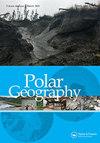Generating a supraglacial melt-lake inventory near Jakobshavn, West Greenland, using a new semi-automated lake-mapping technique
IF 1.6
Q3 GEOGRAPHY, PHYSICAL
引用次数: 1
Abstract
ABSTRACT We analyze Landsat-7 imagery spanning a 13-year period (2000–2012) for the Jakobshavn Ablation Region (JAR) along the west coast of Greenland. In addition, we introduce a new semi-automated technique for the mapping of melt-lakes using FoveaPro image-processing software (plug-in to Adobe Photoshop™), greatly simplifying the process, and resulting in more-precise spatial melt-lake statistics over existing manual methods. We found a total mean melt-lake area of 0.30 ± 0.12 km2 (±1σ), with maximum melt-lake area increasing at an average rate of 0.032 km2 d−1 across the study periods. Additionally, we note a yearly seasonal increase (∼1.8 m d−1) in the overall mean lake elevation (∼200 m per season) as well as an optimal elevation of the largest-area melt-lakes of ∼1320 ± 20 m (±1σ). We also found an increase in the maximum average melt-lake elevation (MAME) of ∼3.8 m a−1 (∼50 m). Based on data recorded at nearby automated weather stations, the mean seasonal temperature increased ∼1.6°C over the 13-year period at an average rate of 0.125°C a−1. Although temperature is a driver for meltwater production, we conclude that mechanisms related to the surface topography are more likely modulating the spatial pattern and characteristics of melt lakes in the ablation zone.利用一种新的半自动化湖泊测绘技术,在西格陵兰岛雅各布港附近生成一个冰川上融化的湖泊清单
我们分析了格陵兰岛西海岸雅各布港消融区(Jakobshavn Ablation Region, JAR) 13年(2000-2012)的Landsat-7卫星图像。此外,我们引入了一种新的半自动化技术,用于使用FoveaPro图像处理软件(插件到Adobe Photoshop™)绘制融化湖,大大简化了这一过程,并产生比现有的手动方法更精确的空间融化湖统计。研究发现,在整个研究期间,融化湖的总平均面积为0.30±0.12 km2(±1σ),最大融化湖面积以0.032 km2 d - 1的平均速率增加。此外,我们注意到总体平均湖泊高程(每季约200米)呈年季节性增加(约1.8米d−1),最大面积融化湖的最佳高程为约1320±20米(±1σ)。我们还发现最大平均融化湖高程(MAME)增加了~ 3.8 ma−1 (~ 50 m)。根据附近自动气象站记录的数据,平均季节温度在13年期间以0.125°C a - 1的平均速率上升了~ 1.6°C。虽然温度是融水产生的驱动因素,但我们认为与地表地形有关的机制更有可能调节融冰区融湖的空间格局和特征。
本文章由计算机程序翻译,如有差异,请以英文原文为准。
求助全文
约1分钟内获得全文
求助全文
来源期刊

Polar Geography
GEOGRAPHY, PHYSICAL-
CiteScore
5.30
自引率
0.00%
发文量
13
期刊介绍:
Polar Geographyis a quarterly publication that offers a venue for scholarly research on the physical and human aspects of the Polar Regions. The journal seeks to address the component interplay of the natural systems, the complex historical, political, economic, cultural, diplomatic, and security issues, and the interchange amongst them. As such, the journal welcomes comparative approaches, critical scholarship, and alternative and disparate perspectives from around the globe. The journal offers scientists a venue for publishing longer papers such as might result from distillation of a thesis, or review papers that place in global context results from coordinated national and international efforts currently underway in both Polar Regions.
 求助内容:
求助内容: 应助结果提醒方式:
应助结果提醒方式:


